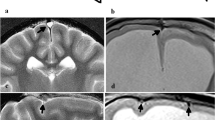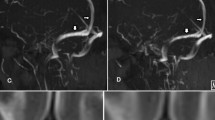Summary
The arachnoid villi of 18 dogs were studied. The authors confirmed the pressure gradient changes of the morphology of arachnoid villi of dogs with the scanning electron microscope (SEM). A subarachnoid infusion with 5–10 times higher pressure gradient than the physiological one, tore the superficial endothelial layer from the villi, and the inner part could also be observed stereoscopically. On the surface of the arachnoid villi the authors observed microvilli, openings of vacuoles and intercellular gaps, but did not find openings of preformed channels. After subarachnoid haemorrhage (SAH) generally the villi were blocked but the authors have observed a red blood cell escaping from a villus intercellularly.
Similar content being viewed by others
References
Alksne, J. F., Lovings, E. T., The role of the arachnoid villus in the removal of red blood cells from the subarachnoid space. An electron microscope study in the dog. J. Neurosurg.36 (1972), 192–200.
Alksne, J. F., Lovings, E. T., Functional ultrastructure of the arachnoid villus. Arch. Neurol.27 (1972), 371–376.
Alksne, J. F., White, L. E., Jr., Electron-microscope study of the effect of increased intracranial pressure on the arachnoid villus. J. Neurosurg.22 (1965), 481–488.
Blaylock, R. L., Kempe, L. G., Hydrocephalus associated with subarachnoid haemorrhage. Neurochirurgia21 (1978), 20–28.
Davson, H., Physiology of the ocular- and cerebrospinal fluid. Little, Brown (1967), 1956.
Ellington, E., Margolis, G., Block of arachnoid villus by subarachnoid hemorrhage. J. Neurosurg.30 (1969), 651–657.
Gomez, D. G., Potts, D. G., Deonarine, V. R. T., Reilly, K. F., Effects of pressure gradient changes on the morphology of arachnoid villi and granulations of the monkey. Lab. Invest.28 (1973), 648–657.
Gomez, D. G., Potts, D. G., The surface characteristics of arachnoid granulations. A scanning electron microscopical study. Arch. Neurol.31 (1974), 88–93.
Jayatilaka, A. D. P., An electron microscopic study of sheep arachnoid granulations. J. Anat.99 (1965), 635–649.
Potts D. G., Deonarine, V., Welton, W., Perfusion studies of the cerebrospinal fluid absorptive pathways in the dog. Radiology105 (1972), 321–325.
Potts, D. G., Reilly, K. F., Deonarine, V., Morphology of the arachnoid villi and granulations. Radiology105 (1972), 333–341.
Potts, D. G., Deonarine, V., Effect of positional changes and jugular vein compression on the pressure gradient across the arachnoid villi and granulations of the dog. J. Neurosurg.38 (1973), 722–728.
Shabo, A. L., Maxwell, D. S., The morphology of the arachnoid villi: A light and electron microscopic study in the monkey. J. Neurosurg.29 (1968), 451–463.
Shabo, A. L., Maxwell, D. S., Electron microscopic observations on the fate of particulate matter in the cerebrospinal fluid. J. Neurosurg.29 (1978), 464–474.
Torvik, A., Bhatia, R., Murthy, V. S., Transitory block of the arachnoid granulations following subarachnoid haemorrhage. A postmortem study. Acta Neurochir. (Wien)41 (1978), 137–146.
Tripathi, B. J., Tripathi, R. C., Vacuolar transcellular channels as a drainage pathway for cerebrospinal fluid. J. Physiol.239 (1974), 195–206.
Tripathi, R., Tracing the bulk outflow route of cerebrospinal fluid by transmission and scanning electron microscopy. Brain Res.80 (1974), 503–506.
Tripathi, R. C., Ultrastructure of the arachnoid mater in relation to outflow of cerebrospinal fluid. A new concept. Lancet7 (1973), 8–11.
Weed, L. H., The absorption of cerebrospinal fluid into the venous system. Amer. J. Anat.31 (1923), 191–221.
Weed, L. H., Hugson, Studies on cerebrospinal fluid. III. The pathways of escape from the subarachnoid spaces with particular reference to the arachnoid villi. J. med. Res.31 (1919), 51–91.
Welch, K., Friedman, V., The cerebrospinal fluid valves. Brain83 (1960), 454–469.
Welch, K., Pollay, M., Perfusion of particles through arachnoid villi of the monkey. Amer. J. Physiol.201 (1961), 651–654.
Author information
Authors and Affiliations
Additional information
This work was supported by the Japan Society for the Promotion of Science. Budapest, Hungary.
Visiting Research Associate from National Institute of Neurosurgery,
Rights and permissions
About this article
Cite this article
Julow, J., Ishii, M. & Iwabuchi, T. Arachnoid villi affected by subarachnoid pressure and haemorrhage. Acta neurochir 51, 63–72 (1979). https://doi.org/10.1007/BF01401795
Issue Date:
DOI: https://doi.org/10.1007/BF01401795




